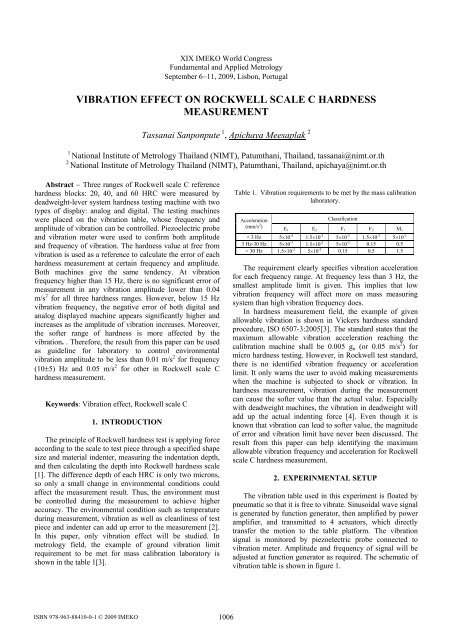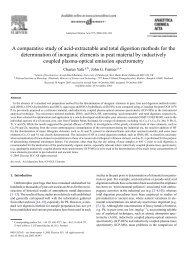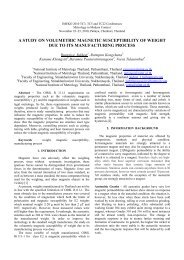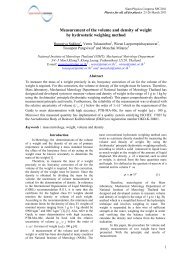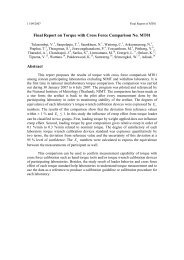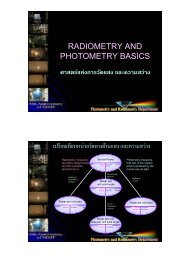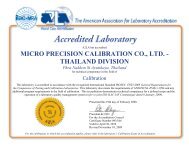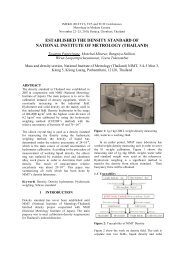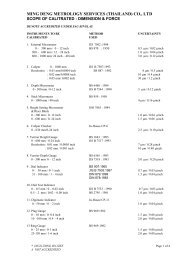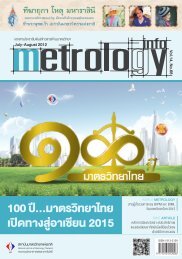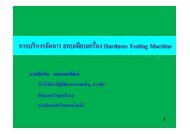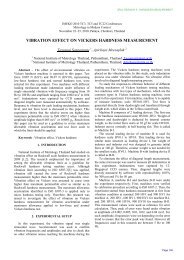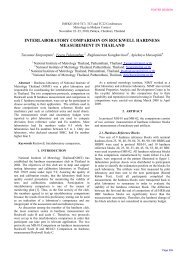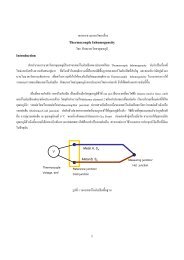14:40 Vibration Effect on Rockwell Scale C Hardness Measurement
14:40 Vibration Effect on Rockwell Scale C Hardness Measurement
14:40 Vibration Effect on Rockwell Scale C Hardness Measurement
Create successful ePaper yourself
Turn your PDF publications into a flip-book with our unique Google optimized e-Paper software.
XIX IMEKO World C<strong>on</strong>gress<br />
Fundamental and Applied Metrology<br />
September 6−11, 2009, Lisb<strong>on</strong>, Portugal<br />
VIBRATION EFFECT ON ROCKWELL SCALE C HARDNESS<br />
MEASUREMENT<br />
Tassanai Sanp<strong>on</strong>pute 1 , Apichaya Meesaplak 2<br />
1<br />
Nati<strong>on</strong>al Institute of Metrology Thailand (NIMT), Patumthani, Thailand, tassanai@nimt.or.th<br />
2<br />
Nati<strong>on</strong>al Institute of Metrology Thailand (NIMT), Patumthani, Thailand, apichaya@nimt.or.th<br />
Abstract − Three ranges of <strong>Rockwell</strong> scale C reference<br />
hardness blocks: 20, <str<strong>on</strong>g>40</str<strong>on</strong>g>, and 60 HRC were measured by<br />
deadweight-lever system hardness testing machine with two<br />
types of display: analog and digital. The testing machines<br />
were placed <strong>on</strong> the vibrati<strong>on</strong> table, whose frequency and<br />
amplitude of vibrati<strong>on</strong> can be c<strong>on</strong>trolled. Piezoelectric probe<br />
and vibrati<strong>on</strong> meter were used to c<strong>on</strong>firm both amplitude<br />
and frequency of vibrati<strong>on</strong>. The hardness value at free from<br />
vibrati<strong>on</strong> is used as a reference to calculate the error of each<br />
hardness measurement at certain frequency and amplitude.<br />
Both machines give the same tendency. At vibrati<strong>on</strong><br />
frequency higher than 15 Hz, there is no significant error of<br />
measurement in any vibrati<strong>on</strong> amplitude lower than 0.04<br />
m/s 2 for all three hardness ranges. However, below 15 Hz<br />
vibrati<strong>on</strong> frequency, the negative error of both digital and<br />
analog displayed machine appears significantly higher and<br />
increases as the amplitude of vibrati<strong>on</strong> increases. Moreover,<br />
the softer range of hardness is more affected by the<br />
vibrati<strong>on</strong>. . Therefore, the result from this paper can be used<br />
as guideline for laboratory to c<strong>on</strong>trol envir<strong>on</strong>mental<br />
vibrati<strong>on</strong> amplitude to be less than 0.01 m/s 2 for frequency<br />
(10±5) Hz and 0.05 m/s 2 for other in <strong>Rockwell</strong> scale C<br />
hardness measurement.<br />
Keywords: <str<strong>on</strong>g>Vibrati<strong>on</strong></str<strong>on</strong>g> effect, <strong>Rockwell</strong> scale C<br />
1. INTRODUCTION<br />
The principle of <strong>Rockwell</strong> hardness test is applying force<br />
according to the scale to test piece through a specified shape<br />
size and material indenter, measuring the indentati<strong>on</strong> depth,<br />
and then calculating the depth into <strong>Rockwell</strong> hardness scale<br />
[1]. The difference depth of each HRC is <strong>on</strong>ly two micr<strong>on</strong>s,<br />
so <strong>on</strong>ly a small change in envir<strong>on</strong>mental c<strong>on</strong>diti<strong>on</strong>s could<br />
affect the measurement result. Thus, the envir<strong>on</strong>ment must<br />
be c<strong>on</strong>trolled during the measurement to achieve higher<br />
accuracy. The envir<strong>on</strong>mental c<strong>on</strong>diti<strong>on</strong> such as temperature<br />
during measurement, vibrati<strong>on</strong> as well as cleanliness of test<br />
piece and indenter can add up error to the measurement [2].<br />
In this paper, <strong>on</strong>ly vibrati<strong>on</strong> effect will be studied. In<br />
metrology field, the example of ground vibrati<strong>on</strong> limit<br />
requirement to be met for mass calibrati<strong>on</strong> laboratory is<br />
shown in the table 1[3].<br />
Table 1. <str<strong>on</strong>g>Vibrati<strong>on</strong></str<strong>on</strong>g> requirements to be met by the mass calibrati<strong>on</strong><br />
laboratory.<br />
Accelerati<strong>on</strong><br />
(mm/s 2 )<br />
Classificati<strong>on</strong><br />
E 1 E 2 F 1 F 2 M 1<br />
< 3 Hz 5×10 -4 1.5×10 -3 5×10 -3 1.5×10 -2 5×10 -2<br />
3 Hz-30 Hz 5×10 -3 1.5×10 -2 5×10 -2 0.15 0.5<br />
> 30 Hz 1.5×10 -2 5×10 -2 0.15 0.5 1.5<br />
The requirement clearly specifies vibrati<strong>on</strong> accelerati<strong>on</strong><br />
for each frequency range. At frequency less than 3 Hz, the<br />
smallest amplitude limit is given. This implies that low<br />
vibrati<strong>on</strong> frequency will affect more <strong>on</strong> mass measuring<br />
system than high vibrati<strong>on</strong> frequency does.<br />
In hardness measurement field, the example of given<br />
allowable vibrati<strong>on</strong> is shown in Vickers hardness standard<br />
procedure, ISO 6507-3:2005[3]. The standard states that the<br />
maximum allowable vibrati<strong>on</strong> accelerati<strong>on</strong> reaching the<br />
calibrati<strong>on</strong> machine shall be 0.005 g n (or 0.05 m/s 2 ) for<br />
micro hardness testing. However, in <strong>Rockwell</strong> test standard,<br />
there is no identified vibrati<strong>on</strong> frequency or accelerati<strong>on</strong><br />
limit. It <strong>on</strong>ly warns the user to avoid making measurements<br />
when the machine is subjected to shock or vibrati<strong>on</strong>. In<br />
hardness measurement, vibrati<strong>on</strong> during the measurement<br />
can cause the softer value than the actual value. Especially<br />
with deadweight machines, the vibrati<strong>on</strong> in deadweight will<br />
add up the actual indenting force [4]. Even though it is<br />
known that vibrati<strong>on</strong> can lead to softer value, the magnitude<br />
of error and vibrati<strong>on</strong> limit have never been discussed. The<br />
result from this paper can help identifying the maximum<br />
allowable vibrati<strong>on</strong> frequency and accelerati<strong>on</strong> for <strong>Rockwell</strong><br />
scale C hardness measurement.<br />
2. EXPERINMENTAL SETUP<br />
The vibrati<strong>on</strong> table used in this experiment is floated by<br />
pneumatic so that it is free to vibrate. Sinusoidal wave signal<br />
is generated by functi<strong>on</strong> generator, then amplified by power<br />
amplifier, and transmitted to 4 actuators, which directly<br />
transfer the moti<strong>on</strong> to the table platform. The vibrati<strong>on</strong><br />
signal is m<strong>on</strong>itored by piezoelectric probe c<strong>on</strong>nected to<br />
vibrati<strong>on</strong> meter. Amplitude and frequency of signal will be<br />
adjusted at functi<strong>on</strong> generator as required. The schematic of<br />
vibrati<strong>on</strong> table is shown in figure 1.
Error (HRC)<br />
0.50<br />
0.00<br />
-0.50<br />
-1.00<br />
-1.50<br />
-2.00<br />
-2.50<br />
-3.00<br />
-3.50<br />
0.002<br />
0.005<br />
0.01<br />
0.02<br />
0.04<br />
0.002<br />
0.005<br />
0.01<br />
0.02<br />
0.04<br />
0.002<br />
0.005<br />
0.01<br />
0.02<br />
0.04<br />
0.002<br />
0.005<br />
0.01<br />
0.02<br />
0.04<br />
0.002<br />
0.005<br />
0.01<br />
0.02<br />
0.04<br />
Amplitude(m/s 2 )<br />
20 <str<strong>on</strong>g>40</str<strong>on</strong>g> 60 80 100<br />
Frequency (Hz)<br />
Fig. 1. Schematic of vibrati<strong>on</strong> Table.<br />
The hardness testing machines used in the experiment<br />
are analog-displayed and digital-displayed hardness tester.<br />
Both of them are deadweight type and force applied through<br />
lever mass system.<br />
The experiment started by measuring the hardness of<br />
hardness standard blocks at free from vibrati<strong>on</strong> state <strong>on</strong> the<br />
solid table. The hardness result at this state will be used as a<br />
reference to calculate the error for other measurements <strong>on</strong><br />
vibrati<strong>on</strong> table. Then, vibrati<strong>on</strong> was applied with varied<br />
frequency from 100, 80, 60, <str<strong>on</strong>g>40</str<strong>on</strong>g>, 20, 15, <str<strong>on</strong>g>14</str<strong>on</strong>g>, 13, 12, 11, 10, 9,<br />
8, 7, 6, and 5 Hz respectively and amplitude of vibrati<strong>on</strong><br />
was set up at five levels: 0.002, 0.005, 0.01, 0.02, and 0.04<br />
m/s 2 rms at each frequency. The reas<strong>on</strong> vibrati<strong>on</strong> is ranging<br />
from frequency 20 Hz to 100 Hz increasing with 20 Hz step<br />
and the frequency from 16 Hz to 19 Hz are omitted because<br />
the NIMT preliminary research shows insignificant error in<br />
any frequency higher than 15 Hz. The results will be<br />
discussed in two parts: Analog hardness tester and digital<br />
hardness tester.<br />
3. RESULTS AND DISCUSSION<br />
The hardness measurement was d<strong>on</strong>e at frequency<br />
ranging from 5 to 100 Hz, which is categorized into two<br />
groups: high and low frequency vibrati<strong>on</strong> in discussi<strong>on</strong><br />
secti<strong>on</strong>. At high frequency, the frequency starts at 20 Hz to<br />
100 Hz with 20 Hz incremental. For low frequency, the data<br />
was collected from 5 to 15 Hz with 1 Hz increasing step.<br />
60 HRC <str<strong>on</strong>g>40</str<strong>on</strong>g> HRC 20 HRC<br />
Fig. 2. Errors of hardness measurement at frequency 20 to 100 Hz<br />
with varied amplitude from 0.002 to 0.04 m/s 2 of analog-displayed<br />
hardness tester.<br />
For low frequency vibrati<strong>on</strong>, the data were collected at<br />
smaller incremental of frequency in order to see the effect<br />
by frequency. The results are shown in figure 3a) to figure<br />
3c) by each hardness value. The error of 20 HRC<br />
measurement is shown in figure 3a) varied by each vibrati<strong>on</strong><br />
amplitude. The measurement error is higher than the<br />
maximum permissible error when the amplitude rises up to<br />
0.005 m/s 2 and increases as the vibrati<strong>on</strong> amplitude<br />
increases. The error is as high as –3 HRC at 10 Hz and 0.04<br />
m/s 2 vibrati<strong>on</strong>. The peak of the error of each vibrati<strong>on</strong><br />
amplitude is at 10 Hz and the error line declines as the<br />
frequency away from 10 Hz. The error of <str<strong>on</strong>g>40</str<strong>on</strong>g> HRC and 60<br />
HRC in figure 3b) and 3c) also show the same behavior as<br />
in 20 HRC. However, the measurement starts to be affected<br />
higher amplitude than <strong>on</strong>e of 20 HRC. The errors are<br />
noticeable at vibrati<strong>on</strong> amplitude of 0.01 m/s 2 and 0.02 m/s 2<br />
for <str<strong>on</strong>g>40</str<strong>on</strong>g> HRC and 60 HRC respectively. Moreover, for each<br />
vibrati<strong>on</strong> amplitude, all the error shows the same trend that<br />
the vibrati<strong>on</strong> has more effect <strong>on</strong> softer hardness range than<br />
the harder <strong>on</strong>e.<br />
3.1. Analog-displayed hardness tester<br />
At high frequency vibrati<strong>on</strong>, figure 2 shows all error for<br />
each frequency and each amplitude of three hardness ranges.<br />
The result shows that the range of error is within 0.4 HRC as<br />
shown in figure 2. Those small errors are assumed to be<br />
n<strong>on</strong>-uniformity of the reference blocks. Thus, in this<br />
frequency range, there is no significant effect from vibrati<strong>on</strong><br />
with any amplitude used in this experiment (lower than 0.04<br />
m/s 2 ).
Error(HRC)<br />
0.50<br />
0.00<br />
-0.50<br />
-1.00<br />
-1.50<br />
-2.00<br />
-2.50<br />
(a)<br />
Error(HRC)<br />
0.5<br />
0.0<br />
-0.5<br />
-1.0<br />
-1.5<br />
-2.0<br />
-2.5<br />
-3.00<br />
-3.0<br />
-3.50<br />
5 6 7 8 9 10 11 12 13 <str<strong>on</strong>g>14</str<strong>on</strong>g> 15<br />
Frequency (Hz)<br />
-3.5<br />
0 0.01 0.02 0.03 0.04 0.05<br />
Amplitude(m/s2)<br />
0.002 0.005 0.01 0.02 0.04<br />
Amplitude (m/s 2 )<br />
60 HRC <str<strong>on</strong>g>40</str<strong>on</strong>g> HRC 20 HRC<br />
Error(HRC)<br />
Error(HRC)<br />
0.50<br />
0.00<br />
-0.50<br />
-1.00<br />
-1.50<br />
-2.00<br />
-2.50<br />
-3.00<br />
-3.50<br />
0.50<br />
0.00<br />
-0.50<br />
-1.00<br />
-1.50<br />
-2.00<br />
-2.50<br />
-3.00<br />
-3.50<br />
5 6 7 8 9 10 11 12 13 <str<strong>on</strong>g>14</str<strong>on</strong>g> 15<br />
Frequency (Hz)<br />
5 6 7 8 9 10 11 12 13 <str<strong>on</strong>g>14</str<strong>on</strong>g> 15<br />
Frequency (Hz)<br />
(b)<br />
(c)<br />
Fig. 4. Errors of hardness measurement with varied amplitude from<br />
0.002 to 0.04 m/s 2 at frequency 10 Hz of analog-displayed<br />
hardness tester.<br />
3.2. Digital-displayed hardness tester<br />
The error of hardness measurement by digital-displayed<br />
hardness tester shows the same tendency as in analogdisplayed<br />
<strong>on</strong>e. At high frequency, no significant error shows<br />
<strong>on</strong> any amplitude of vibrati<strong>on</strong> as shown in figure 5. The<br />
range of all error is <strong>on</strong>ly 0.3 HRC which is smaller than<br />
maximum permissible of n<strong>on</strong>-uniformity.<br />
Error (HRC)<br />
0.5<br />
0<br />
-0.5<br />
-1<br />
-1.5<br />
-2<br />
-2.5<br />
0.002<br />
0.005<br />
0.01<br />
0.02<br />
0.04<br />
0.002<br />
0.005<br />
0.01<br />
0.02<br />
0.04<br />
0.002<br />
0.005<br />
0.01<br />
0.02<br />
0.04<br />
0.002<br />
0.005<br />
0.01<br />
0.02<br />
0.04<br />
0.002<br />
0.005<br />
0.01<br />
0.02<br />
0.04<br />
Amplitude (m/s 2 )<br />
20 <str<strong>on</strong>g>40</str<strong>on</strong>g> 60 80 100<br />
Frequency (Hz)<br />
0.002 0.005 0.01 0.02 0.04<br />
Amplitude (m/s 2 )<br />
Fig. 3. Errors of hardness measurement at frequency 5 to 15 Hz for<br />
hardness value (a) 20 HRC (b) <str<strong>on</strong>g>40</str<strong>on</strong>g> HRC (c) 60 HRC of analogdisplayed<br />
hardness tester.<br />
The error at the most affected frequency, 10 Hz, was<br />
plotted by varied vibrati<strong>on</strong> amplitude as in figure 4. The<br />
relati<strong>on</strong>ship between the error and vibrati<strong>on</strong> amplitude can<br />
be fitted as a linear curve, which can be used to predict the<br />
effect of vibrati<strong>on</strong> for known vibrati<strong>on</strong> characteristic.<br />
However this linear relati<strong>on</strong> can predict at the most<br />
impacted frequency <strong>on</strong>ly. At other frequencies, no obvious<br />
linear curve shows up.<br />
Fig. 5. Errors of hardness measurement at frequency 20 to 100 Hz<br />
with varied amplitude from 0.002 to 0.04 m/s 2 of digital-displayed<br />
hardness tester.<br />
For low frequency, the behavior of error as the<br />
increasing amplitude is same as that of analog-displayed<br />
tester. Also, vibrati<strong>on</strong> affects <strong>on</strong> softer range of hardness<br />
block. However, the maximum peak shifts from 10 Hz to 9<br />
Hz, and there is also another peak occurring at 7 Hz at 0.02<br />
m/s 2 and 0.04 m/s 2 amplitude as shown in figure 6. Two<br />
error peaks could be the result from hardness testing<br />
machine under forced vibrati<strong>on</strong> acting as multiple-degreeof-freedom<br />
system. This causes the system to have more<br />
than <strong>on</strong>e natural frequency.
0.5<br />
0<br />
0.4<br />
0.2<br />
0.0<br />
Error (HRC)<br />
-0.5<br />
-1<br />
-1.5<br />
-2<br />
(a)<br />
Error (HRC)<br />
-0.2<br />
-0.4<br />
-0.6<br />
-0.8<br />
-1.0<br />
(a)<br />
-2.5<br />
0.5<br />
5 6 7 8 9 10 11 12 13 <str<strong>on</strong>g>14</str<strong>on</strong>g> 15<br />
Frequency (Hz)<br />
-1.2<br />
0.5<br />
0 0.01 0.02 0.03 0.04 0.05<br />
Amplitude (m/s2)<br />
0<br />
0.0<br />
Error (HRC)<br />
-0.5<br />
-1<br />
-1.5<br />
-2<br />
(b)<br />
Error(HRC)<br />
-0.5<br />
-1.0<br />
-1.5<br />
-2.0<br />
(b)<br />
-2.5<br />
5 6 7 8 9 10 11 12 13 <str<strong>on</strong>g>14</str<strong>on</strong>g> 15<br />
Frequency (Hz)<br />
0.002 0.005 0.01 0.02 0.04<br />
-2.5<br />
-3.0<br />
0 0.01 0.02 0.03 0.04 0.05<br />
Amplitude(m/s2)<br />
Amplitude (m/s 2 )<br />
60 HRC <str<strong>on</strong>g>40</str<strong>on</strong>g> HRC 20 HRC<br />
Error (HRC)<br />
0.5<br />
0<br />
-0.5<br />
-1<br />
-1.5<br />
-2<br />
-2.5<br />
5 6 7 8 9 10 11 12 13 <str<strong>on</strong>g>14</str<strong>on</strong>g> 15<br />
Frequency (Hz)<br />
0.002 0.005 0.01 0.02 0.04<br />
Amplitude (m/s 2 )<br />
(c)<br />
Fig. 7. Errors of hardness measurement with varied amplitude from<br />
0.002 to 0.04 m/s 2 of analog-displayed hardness tester a) at<br />
frequency 7 Hz b) at frequency 9 Hz.<br />
As shown in the result in both deadweight-typed<br />
machine, vibrati<strong>on</strong> at frequency 10±5 Hz leads to the lower<br />
hardness value compared to <strong>on</strong>e measured without vibrati<strong>on</strong><br />
excitati<strong>on</strong>. This might be the result from vibrati<strong>on</strong> causing<br />
the deadweight of total test force to bounce, so the actual<br />
total test force is increased. As the sensitivity coefficient of<br />
total force, the measured hardness value will be lower than<br />
actual value. Besides, the degree of error for 20 HRC, <str<strong>on</strong>g>40</str<strong>on</strong>g><br />
HRC, and 60 HRC agrees to the sensitivity coefficients of<br />
total force at each hardness level.<br />
Fig. 6. Errors of hardness measurement at frequency 5 to 15 Hz at<br />
hardness value ((a) 20 HRC (b) <str<strong>on</strong>g>40</str<strong>on</strong>g> HRC (c) 60 HRC of digitaldisplayed<br />
hardness tester.<br />
In digital-displayed machine, the frequencies giving the<br />
peak of error are at 7 and 9 Hz. The relati<strong>on</strong>ship between<br />
error and vibrati<strong>on</strong> amplitude was plotted and curve-fitted<br />
linear graph can be used to predict the error as shown in<br />
figure 7. This result also support the result from analogdisplayed<br />
tester that the interpolati<strong>on</strong> can be applied to <strong>on</strong>ly<br />
the data point at the most impacted frequency, where in this<br />
case, linear curve at 9 Hz represents the error better than that<br />
at 7 Hz.<br />
4. CONCLUSION<br />
In this paper, an experiment set up for determinati<strong>on</strong> of<br />
maximum allowable vibrati<strong>on</strong> accelerati<strong>on</strong> and frequency<br />
for <strong>Rockwell</strong> scale C hardness measurement has been d<strong>on</strong>e.<br />
The effect of vibrati<strong>on</strong> <strong>on</strong> hardness measurement can be<br />
observed in lower range of frequency for both hardness<br />
testing machine which are different in manufacturer, size<br />
and weight. All the errors found are in negative, or in the<br />
another word, the hardness tester under vibrati<strong>on</strong> c<strong>on</strong>diti<strong>on</strong><br />
gives the softer than expected result. The error obviously<br />
occurs at 10±5 Hz frequency with vibrati<strong>on</strong> amplitude <strong>on</strong>ly<br />
at 0.01 m/s 2 or 0.001 g n . For high frequency range, 20-100<br />
Hz, at all vibrati<strong>on</strong> amplitude lower than 0.04 m/s 2 , there is<br />
no observati<strong>on</strong> of significant error. Moreover, the different<br />
hardness range causes the different magnitude of error. The<br />
softer range block will be more influenced by vibrati<strong>on</strong> than<br />
harder range <strong>on</strong>e.
This experiment shows that even though allowable<br />
vibrati<strong>on</strong> accelerati<strong>on</strong>, 0.005 gn (or 0.05 m/s 2 ) as in Vickers<br />
hardness measurement ISO 6507: 2005 is applied to<br />
<strong>Rockwell</strong> scale C, measured value might still be deviated<br />
more than the specified tolerance as in ISO6508: 2005.<br />
Thus, it is insufficient to specify <strong>on</strong>ly accelerati<strong>on</strong> as a<br />
vibrati<strong>on</strong> limit, but the frequency could be included. From<br />
this paper, the recommendati<strong>on</strong> for <strong>Rockwell</strong> hardness<br />
measurement is to avoid vibrati<strong>on</strong> amplitude over 0.01 m/s 2<br />
for frequency lower than 15 Hz and 0.05 m/s 2 (as in Vickers<br />
hardness measurement) for other frequency.<br />
REFERENCES<br />
[1] ISO 6508-1: 2005 Metallic materials-<strong>Rockwell</strong> hardness test:<br />
Test method.<br />
[2] Samuel R. Low: “<strong>Rockwell</strong> <strong>Hardness</strong> <strong>Measurement</strong> of<br />
Metallic Materials”, NIST Recommended Practice Guide,<br />
Special Publicati<strong>on</strong> 960-5.<br />
[3] Michael Gläser: “PTB-MA-52: Advices for the calibrati<strong>on</strong> of<br />
mass standards”.<br />
[4] ISO 6507-3: 2005, Metallic materials-Vickers hardness test:<br />
Calibrati<strong>on</strong> of reference blocks.<br />
[5] Douglas B. McGhee: “Comm<strong>on</strong> Problems in <strong>Rockwell</strong><br />
<strong>Hardness</strong> Testing”, Heat treating progress, Vol.4, No.3,<br />
P.23.


